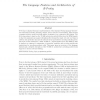Free Online Productivity Tools
i2Speak
i2Symbol
i2OCR
iTex2Img
iWeb2Print
iWeb2Shot
i2Type
iPdf2Split
iPdf2Merge
i2Bopomofo
i2Arabic
i2Style
i2Image
i2PDF
iLatex2Rtf
Sci2ools
CORR
2011
Springer
2011
Springer
The Language Features and Architecture of B-Prolog
B-Prolog is a high-performance implementation of the standard Prolog language with several extensions including matching clauses, action rules for event handling, finite-domain constraint solving, arrays and hash tables, declarative loop constructs, and tabling. The B-Prolog system is based on the TOAM architecture which differs from the WAM mainly in that (1) arguments are passed old-fashionedly through the stack, (2) only one frame is used for each predicate call, and (3) instructions are provided for encoding matching trees. The most recent architecture, called TOAM Jr., departs further from the WAM in that it employs no registers for arguments or temporary variables, and provides variable-size instructions for encoding predicate calls. This paper gives an overview of the language features and a detailed description of the TOAM Jr. architecture, including architectural support for action rules and tabling.
| Added | 13 May 2011 |
| Updated | 13 May 2011 |
| Type | Journal |
| Year | 2011 |
| Where | CORR |
| Authors | Neng-Fa Zhou |
Comments (0)

